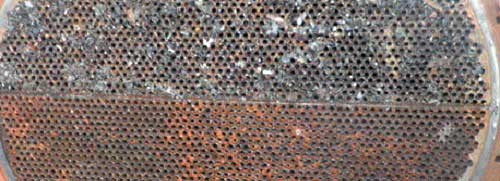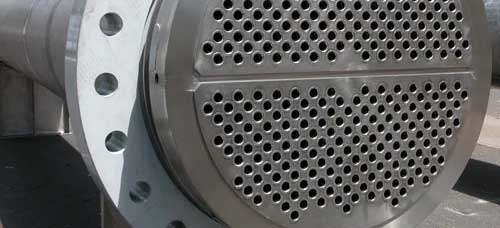 |
Fouling & Scaling in Heat Exchangers |
The deposition of unwanted materials such as scale, suspended particles, insoluble salts and even algae on the internal surfaces of the heat exchanger is called fouling.
It occurs in all industries and in most heat exchanger designs, with consequences ranging from heat transfer deterioration to flow resistance and pressure losses. By forming a type of insulation on heat transfer surfaces and reducing heat transfer, fouling undermines heat exchange efficiency.
The presence of these deposits forms a resistance to fluid flow and heat transfer, thereby increasing the pressure drop and lowering the efficiency of the heat exchanger.
The degree of fouling varies considerably with the physical properties of the fluids being treated. With severe fouling, the heat exchanger can become clogged and thus stop working due to back pressure.
Depending on the fouling, this can lead to corrosion of the heat exchanger that is often hidden by the fouling layer itself. This shortens the life of the heat exchanger and can lead to catastrophic failure.
Types of Fouling
There are different types of fouling, which can vary depending on different factors, such as the operating conditions in which the heat exchanger is used.
There are also different terms used worldwide for the different types of fouling, and this can lead to confusion about what is happening in a particular situation. Simply put, fouling can consist of crystalline, biological material, the products of chemical reactions including corrosion, or suspended particles.
The nature of the deposit depends on the fluid (liquid or gas) flowing through the heat exchanger. It may be the bulk fluid itself that causes the problem of fouling, such as the decomposition of an organic fluid under the temperature conditions in the heat exchanger.
The problem of fouling is caused by some form of contamination in the fluid, often in very low concentrations, for example, solid particles or microorganisms.
Scaling
Scaling, also known as chemical fouling, is used to describe the buildup of calcium carbonate, or scale, in heat exchanger tubes as a result of hard water evaporation over time.
Severe scale build-up is common in fluid coils and evaporators in saturated environments and in other wet applications and reduces both the flow rate and thermal performance of the fluid to the outer tube wall or of the airflow to the internally circulated fluid.
Like most types of fouling, the presence of scaling is indicated by increased pressure drop, so inlet and outlet temperatures should be documented regularly to clear scaling before the tubes become completely clogged.
 Internally fouled bundle tubes
Internally fouled bundle tubes
Contamination can occur from the fluids being treated and their constituents combined with operating conditions such as temperature and velocity.
Almost any solid or soft material can become a heat exchanger pollutant, but some materials commonly found as pollutants in industrial processes are..
- iron oxide
- organic materials
- inorganic materials
- mud and sludge in water
- dust and grit in the air
- calcium and magnesium salts
- heavy organic deposits such as.. polymers, tar and carbon
- organic materials such as.. bacteria, fungi and algae, oils, waxes and greases
- biological materials, such as.. bacteria, fungi and algae, oils, waxes and greases
Fouling removal
Despite the best efforts of engineers and technologists to eliminate fouling of heat exchangers, deposits will still fester.
Periodic cleaning of heat exchangers is necessary to restore the heat exchanger to efficient operation. If deposits are difficult to remove mechanically, chemical cleaning may be necessary.
 Clean Heat Exchanger Bundle
Clean Heat Exchanger Bundle
The chemicals used for this purpose are often aggressive in nature and create an effluent problem after cleaning. Unless properly treated, this wastewater can also pose an environmental problem. Even water used for cleaning can become contaminated and may need appropriate treatment before being discharged.
In all cases, however, the prevention/reduction of fouling is more effective and less expensive than the remedy of removing fouling and cleaning the heat exchanger.
Cost of fouling
The economic aspect of heat exchanger fouling is very important because it affects operating costs and thus the profitability of the company. Initially, the heat exchanger is usually designed too generously to account for fouling. Increasing the size of the heat exchanger naturally increases the initial capital cost and therefore the annual capital cost.
To overcome the effect of flow restriction due to fouling at a given throughput, the speed must be increased, which increases pumping power and cost. Many pumps are electric and so the increased energy requirement is in terms of the more expensive secondary energy. The presence of deposits can also impose other operating costs, such as increased maintenance or reduced production.
Unplanned shutdowns as a direct result of fouling of heat exchangers can be particularly costly. In many cases of severe fouling, the frequency with which the heat exchanger needs to be cleaned does not coincide with the scheduled periodic plant shutdown for maintenance, and it may be necessary to install spare heat exchangers for use when the heat exchanger requires cleaning. The additional heat transfer capacity provided by standby equipment imposes additional capital costs.
References..
www.superradiatorcoils.com
klarenbv.com
www.csidesigns.com